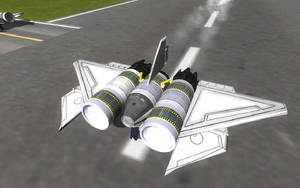Single-stage-to-orbit

A single-stage-to-orbit craft (also known as a SSTO) is any craft that can reach orbit without having to rely on multiple stages or jettisoning components. A typical SSTO takes off from a runway or launchpad and reaches orbit with only the fuel stored within the tanks of the craft. SSTOs are not exclusively required to break orbit and re-enter the atmosphere for a landing as they may be refueled in orbit. Designing a Single Stage to Orbit craft generally requires a firm grasp of spacecraft as well as aircraft design in order to create a craft that can operate both within and outside of an atmosphere without changing aerodynamic profile and size.
As second reconsideration, it is a kind of single stage lander able to reach the stable orbit - as default representation - worked Kerbin's environment. This SSTOs' can work on Laythe too, and there could be definied specific SSTOs for another celestial bodies also.
Contents
History
- It wasn't until C7 released his spaceplane pack in version 0.12 that spaceplanes were truly introduced into Kerbal Space Program.
- Space planes were officially included in Kerbal Space Program following version 0.15 with the addition of the Space Plane Hangar.
Approaches to constructing a SSTO
SSTOs can be constructed using various engines like their siblings the multi-stage rockets, however many issues must be considered when it comes to constructing a spaceplane. They can be constructed with several types of engines and several types of designes.
There are 2 common types of SSTOs that are being created:
- There is the single stage to orbit spaceplane which takes off horizontally from a runway and lands horizontally - this type used more commonly:
- The advantages of this design:
- It is able to reach stable orbit with less thrust (even TWR <1), this can mean serious weight savings.
- It makes easier to control braking and descending at atmospheric entry.
- It is easier to exactly approach the landing site, and search a proper site.
- It can be efficient explorer of the celestial bodies with atmosphere.
- The disadvantages of this design:
- It is very touchy of the properly plane landing site.
- There is also a single stage rocket that takes off vertically and lands vertically.
- The advantages of this design:
- Constructed with proper engines can be used on celestial bodies without atmosphere.
- Less sensitive on evenness of the landing site.
When it comes to choosing engines for SSTOs there are two primary things that need to be addressed, power to weight ratio and efficiency.
- Solid fuel rocket-powered SSTOs are less than ideal since the thrust can not be controlled or vectored in any meaningful way and is unable to use fuel located on other parts of the spacecraft, and cannot be refueled too. Solid rocket engines can be used for escape modules only.
- Air breathing engines, although useless in space, are quite popular launch engines for SSTOs due to their extreme fuel efficiency which allows the SSTO to conserve precious rocket fuel until an altitude where air breathing engines are no longer effective. But these engines should be passed over in case the given craft used primary oxygen-less environment.
- Liquid fuel rockets are ideal for SSTOs due to the ability to control thrust levels as well as the ability to thrust vector. Many SSTOs use aerospike engines due to their excellent power to weight ratio and efficiency, especially in dense atmosphere. The inability to attach separate stages onto aerospike engines has no effect on SSTO design.
- The RAPIER engines seem ideal for the SSTO designs, due to less of a need to have both liquid fuel rockets and jet engines. But a proper composite of liquid fuel rockets and jet engines could be even more efficient.
- Ion engines have too little thrust and need too much electric power (and therefore too many solar panels, RTGs, and batteries) to be considered for large payloads. Some have made ion-powered probe and even single-seater SSTOs.
Whether rocket-powered or air-breathing, a reusable vehicle must be rugged enough to survive multiple round trips into space without adding excessive weight or maintenance. In addition a reusable vehicle must be able to reenter without damage, and land safely.
An example stock craft which is a working single-stage-to-orbit spaceplane is the Aeris 4A.
Issues to consider while constructing
Spaceplane construction is far more involved and complex than rocket design. Whereas when designing rockets one only needs to pay attention to structural stability, center of gravity, and center of thrust, when designing spaceplanes one also needs to be concerned about the center of lift, angle of attack, as well as aerodynamic drag due to the non-symmetrical vertical nature of aircraft.
Features and benefits
- Can be more efficient at reaching orbit than multi-stage rockets when using air breathing engines in atmosphere with oxygen. That is because they use intake air instead of oxidizer while in the atmosphere, reducing weight and fuel requirements.
- Does not jettison expensive engines and structure.
- Prevents having to recover and refurbish jettisoned components.
- Can operate like an aircraft within the atmosphere in case of spaceplane design.
Disadvantages
- Spaceplane type SSTOs cannot be as heavy as a vertical rocket due to structural limitations.
- Spaceplane SSTOs require a solid grasp on aerodynamics.
- Very fuel inefficient for carrying heavy loads into orbit, especially with fully rocket engine propulsion.
- Typically do not carry enough fuel for inter-planetary travel, and their dry/wet weight ratio is worse.
- Harder to design than multi-stage rockets.
See also
- Single-stage-to-orbit on Wikipedia
